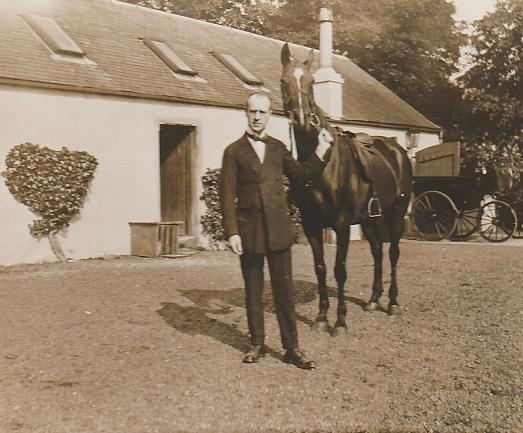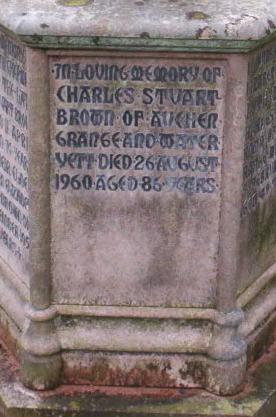
Charles at Auchengrange
| Charles Stuart Brown |
| 5th April 1874 - 26th August 1960 |

Charles at Auchengrange
‘Charles Stewart Brown’, the third son of Peter Stuart Brown and Elizabeth Chapman, was born on 5th April 1874 at six in the morning, at Millburn Cottage, Parish of Bathgate. The informant was Mungo Chapman, his uncle.

Charles saw active service in the Boer War, as attested by a surviving drawing of his horse, captioned My I. L. H. pony. Sketched near Reitz in the Free State, 1900. The abbreviation stands for ‘Imperial Light Horse’. Charles, then residing in the family home at Bothwell Park, Bothwell, was nominated as a trustee and executor in his father’s 1907 Trust Deed and Settlement, in which he was also named as a beneficiary.
Charles Stuart Brown, an aluminium sheet manufacturer (bachelor) aged 41, married Elizabeth Wilson Blyth, a spinster aged 29, on 17th September 1915 at the Grand Hotel, Glasgow, after Banns according to the Forms of the Established Church of Scotland. He was usually resident at Auchengrange, Lochwinnoch and she at 9, Marlborough Gardens, Clarkston, Renfrewshire. Her parents were entered as David Blyth, Solicitor, and Elizabeth Blyth MS Wilson. The witnesses were G. (presumably George) and Elizabeth Stuart Brown.
Charles Stuart Brown acted as the Executor Dative on the personal or moveable estate of his brother, Huntly Gordon Stuart Brown, who died in 1915; in which connection, he was referred to on 21st January 1916 as ‘Charles Stuart Brown, Assistant Manager to the Acme Tea Chest Company Limited, residing at 402 Sauchiehall Street Glasgow’.
Charles accepted the office of trustee and executor to his late father’s estate upon the latter’s death in 1916, as provided for by the terms of his (Peter’s) 1907 Trust Deed and Settlement, alongside his (Charles’s) widowed mother and brothers, Henry and George. Charles, then resident at 402, Sauchiehall Street, Glasgow, appears to have taken a leading part; he appeared before Francis Gilmour Esquire, Justice of the Peace, at Glasgow on 22nd September 1916, and was solemnly sworn and examined.
Charles stood to inherit an equal share in his father’s estate along with his two brothers, Henry and George, and two sisters, Elizabeth and Helen Eva, on their mother’s death in 1927. It is presumed that he actually did so.

Charles Stuart Brown, an aluminium manuacturer (retired), widower of Elizabeth Wilson Blyth, died on 26th August 1960 at 1h 30m pm at Water Yett, Lochwinnoch. He was 86 years of age. The causes of death were certified as congestive cardiac failure and pulmonary oedema from which he had suffered for half a day. The informant was the deceased’s son, Charles (Wilson) Stuart Brown. The following death notice appeared in the Glasgow Herald, 27th August 1960:
STUART-BROWN – At Water Yett, Loch-
Winnoch, on 26th August, 1960, CHARLES
STUART-BROWN (late chairman, Acme
Tea Chest Company Ltd.), in his 87th
year, second son of the late Peter Stuart-
Brown, of Auchengrange, Lochwinnoch –
Service in Lochwinnoch Parish Church on
Monday, 29th inst., at 3 p.m.; friends
desirous of attending please meet at the
church.

Water Yett, 16th February 2014
Charles is recalled as an overweening and dissolute character, whose severe ‘society gambling’ addiction did much to
dissipate the family fortune. He habitually bullied his brother, George, from boyhood onwards and often borrowed
money to cover his losses. These loans were seldom, if ever, repaid. The chaotic state of Charles’s personal
finances at the end of his life is reflected by a string of solicitors’ letters relating to sums of money owed to
George:
MacDonald, Jameson & Co. to Brownlie, Watson & Beckett, dated 21
February 1957
MacDonald, Jameson & Co. to Brownlie, Watson & Beckett, dated
02 April 1957
MacDonald, Jameson & Co. to George Stuart Brown,
dated 11 February 1960
| Feature |
The foregoing feature, composed by Christopher C. Lee and based on information obtained from a personal interview with Charles’s son, Wilson Stuart Brown, and from an ‘obituary’ (actually a notice in the Deaths column) in the Glasgow Herald, 27th August 1960, is extracted from the Dictionary of Scottish Business Biography 1860-1960, Vol. 2 (Aberdeen University Press, 1990, pp. 115-16. However, a note of caution has to be sounded since several of the personal details provided are utterly mystifying:
Charles Stuart BROWN,
Tea chest and aluminium foil manufacturer; b. 6/6/1873, Bathgate, s. of Peter Stuart Brown, tea chest manufacturer and Elizabeth Chapman; m. 17/9/1915, Elizabeth Wilson Blyth; 1 s.; Ch, Acme Tea Chest Co Ltd; d. 26/8/1860, Water Yett, Lochwinnoch.Charles Stuart Brown was born at Bathgate on 6 June 18731 the son of Peter Stuart Brown and Elizabeth Chapman who had married in Edinburgh on 8 September 18642. Charles was the second3 of seven children. He was educated in Inverness and at Allan Glen’s School in Glasgow.
The family were originally from Aberdeenshire4. Peter Stuart Brown was by training an industrial chemist and spent some time in Inverness. From 1908 he resided in Lochwinnoch, Renfrewshire. By his grandson’s admission Peter was the ‘bright spark’ of the family, both innovator and entrepreneur he had many interests. At one stage he owned a chemical plant near Irvine on the Ayrshire coast where he produced sulphate of ammonia. He also had an interest in agricultural fencing. For the Acme Tea Chest Company he patented and produced a plywood tea chest. This was an important innovation for the tea trade as a whole, which had previously relied on hand sawn planks which tended to split. The chests were previously lined with lead which made them very heavy. From Germany, Peter Stuart Brown brought the original method for making aluminium foil which was a much more suitable lining for the plywood chests. Peter died in 19155.
Charles Stuart Brown joined the family business having served in the 18th Imperial Yeomanry Glasgow Regiment during the Boer War. Under Charles Stuart Brown the business expanded. The aluminium linings were produced through a subsidiary company, Empire Aluminium Ltd. Charles Stuart Brown travelled extensively, establishing a foil plant in Colombo, a tea chest business at Cooch Behar in North India and a plywood plant at Nyasaland. In Britain there was, in addition to the Acme plant at Polmadie in Glasgow, a factory at Enfield. Before and during the First World War Charles Stuart Brown worked at Wilmington, North Carolina, making plywood and exporting timber to Britain.
Among the firm’s major customers in Africa, in the years after the Second World War, were Joe Lyons, Dixon Anderson and the Scottish Co-operative Society. In the Far East they worked closely with James Finlay, who acted as their agents and secretaries in Colombo, and Harrison Crossfield.
The aluminium foil had other outlets of course, and the Glasgow based company produced foil for milk bottle tops, butter wrappers, chocolate, pharmaceutical foil for pills, powdered milk satchets (sic), condensor (sic)foil for radios, radar and television. One of the largest markets was for cigarette packaging. These were world wide outlets and before the Second World War included America.
Acme’s biggest competitor was Venesta Limited, which ultimately took it over before being swallowed up itself by Tube Investments and subsequently by Alcan. Charles Stuart Brown retired with Venesta’s successful takeover in 1957. Since 1900 he had been having problems with his sight and by 1936 was totally blind. Despite this disability he continued as chairman and travelled abroad to visit subsidiary companies.
Charles Stuart Brown had married Elizabeth Wilson Blyth the daughter of a lawyer on 17 September 1915. Elizabeth was trained as a nurse at the Glasgow Royal Infirmary but left to work in a private nursing home in Glasgow. It was in the nursing home that she met her husband who was recovering from an operation. The family home was at Auchengrange, overlooking Castle Semple Loch and the village of Lochwinnoch. They had one son, Wilson Stuart Brown.
Charles Stuart Brown seems to have taken little part in public affairs. He was, according to his son, distinctly ‘unpolitical’ (sic). In religion he was a presbyterian and a member of Lochwinnoch Parish Church, although not an elder. He was an enthusiastic painter before he lost his sight and had been a member of the Glasgow Art Club. In recreational terms his real passion was for horses which he bred and raced, not always successfully. He kept a good stable at Auchengrange and was an enthusiastic member of the Lochwinnoch Agricultural Show Committee and the Lanark and Renfrew Hunt. Charles Stuart Brown died, aged 86, on 26 August 1960.
1 Actually 5th April 1874. If Charles had been born on 6th June 1873, then he would
have been 87 when he died on 26th August 1960, not 86 as stated. The same error also appears in the
Glasgow Herald death notice, in which he was stated to be in his 87th year.
2 Peter Stuart Brown and Elizabeth Chapman were married at the bride’s family home in Bathgate on
19th January 1870. Elizabeth’s age was entered as 17, so if she had married more than five years earlier,
she would have been twelve at most.
3 There were indeed seven children but Charles was the third, after Henry and Mungo, not the second. The
same error also appears in the Glasgow Herald death notice.
4 Only Peter and his forebears were from Aberdeenshire.
5 Peter died in 1916, not 1915.